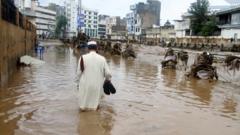The destruction centers predominantly in Khyber Pakhtunkhwa province, where disaster authorities report around 307 fatalities. Among the losses, nine lives have been recorded in Pakistan-administered Kashmir, and five in the northern Gilgit-Baltistan region. The floods have reduced at least 74 homes to rubble, complicating rescue efforts that have already faced setbacks, including a helicopter crash resulting in the deaths of five crew members.
First-hand accounts from survivors describe nightmarish scenes as floodwaters surged unexpectedly. In Buner, one survivor, Azizullah, recounted, “I heard a loud noise, like a mountain collapsing. I rushed outside and witnessed the ground trembling under the sheer force of the water. It felt like death was imminent.”
The chief minister of Khyber Pakhtunkhwa, Ali Amin Gadapur, confirmed that the M-17 rescue helicopter went down due to adverse weather while en route to the Bajaur region, which borders Afghanistan. Meanwhile, in Bajaur, communities gathered to mourn as excavators cleared the mud and debris, unearthing bodies and marking the grim aftermath of the catastrophic flooding.
A day of mourning has been declared in Khyber Pakhtunkhwa, further highlighting the enormity of the disaster. On the Indian-administered side of Kashmir, rescuers have been forced to navigate through mud and rubble, recovering at least 60 bodies as they search for missing individuals after a flood tore through a Himalayan village.
The monsoon season, spanning from June to September, typically accounts for about 75% of South Asia's annual rainfall, leading to common occurrences of floods and landslides. This year alone, the death toll has risen to 650 due to extreme weather from the ongoing monsoon. Notably, Punjab, home to around half of Pakistan's population, has recorded a staggering increase in rainfall this July—73% more than the previous year.
Experts attribute the growing severity and frequency of such weather events to climate change. With northern Pakistan being one of the most glaciated areas, the swift melting of glaciers due to global warming increases the risks of landslides and flooding—a troubling indication of the region's vulnerability.
While scientists work to pinpoint the exact causes behind the latest floods, glaciologists have highlighted the concerning impact of glacial melt on the stability of mountains, underscoring the urgent need for climate action as Pakistan braces for more rain until August 21st.
In scenes that encapsulate both tragedy and resilience, the communities in the affected areas continue to grapple with the aftermath and loss, as floodwaters have not only destroyed infrastructure but also severed lives.
First-hand accounts from survivors describe nightmarish scenes as floodwaters surged unexpectedly. In Buner, one survivor, Azizullah, recounted, “I heard a loud noise, like a mountain collapsing. I rushed outside and witnessed the ground trembling under the sheer force of the water. It felt like death was imminent.”
The chief minister of Khyber Pakhtunkhwa, Ali Amin Gadapur, confirmed that the M-17 rescue helicopter went down due to adverse weather while en route to the Bajaur region, which borders Afghanistan. Meanwhile, in Bajaur, communities gathered to mourn as excavators cleared the mud and debris, unearthing bodies and marking the grim aftermath of the catastrophic flooding.
A day of mourning has been declared in Khyber Pakhtunkhwa, further highlighting the enormity of the disaster. On the Indian-administered side of Kashmir, rescuers have been forced to navigate through mud and rubble, recovering at least 60 bodies as they search for missing individuals after a flood tore through a Himalayan village.
The monsoon season, spanning from June to September, typically accounts for about 75% of South Asia's annual rainfall, leading to common occurrences of floods and landslides. This year alone, the death toll has risen to 650 due to extreme weather from the ongoing monsoon. Notably, Punjab, home to around half of Pakistan's population, has recorded a staggering increase in rainfall this July—73% more than the previous year.
Experts attribute the growing severity and frequency of such weather events to climate change. With northern Pakistan being one of the most glaciated areas, the swift melting of glaciers due to global warming increases the risks of landslides and flooding—a troubling indication of the region's vulnerability.
While scientists work to pinpoint the exact causes behind the latest floods, glaciologists have highlighted the concerning impact of glacial melt on the stability of mountains, underscoring the urgent need for climate action as Pakistan braces for more rain until August 21st.
In scenes that encapsulate both tragedy and resilience, the communities in the affected areas continue to grapple with the aftermath and loss, as floodwaters have not only destroyed infrastructure but also severed lives.


















